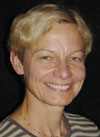
Barbara Romanowicz
for her outstanding contributions to wideranging topics of theoretical seismology and to the development of broadband seismic networks on land and in the oceans
Barbara Romanowicz graduated at the École Normale Supérieure, "Sèvres", Paris, France, in 1974 and she received her Doctorat d'État from the Université Paris 7, Spécialité Géophysique in 1979. She has been Directeur de Recherches, CNRS, Institut de Physique du Globe, Paris and Director of the Geoscope Programme, till 1990. She is now Professor of Geophysics at the University of California, Berkeley and Director of the Berkeley Seismological Laboratory.
Her PhD work on upper mantle tomography under the North American continent has been the fisrt continental scale tomographic model. Many of the features recently described by Van der Lee and Nolet, Grand and others were already mentioned in that work. The two step inversion method for moment tensor determination using surface wave data which she developed, takes advantage of the simple signature of source radiation pattern to minimize the effects of the poorly known path corrections. In developing a higher order asymptotic theory for normal modes, she showed in particular that coupling between multiplets leads to the sensitivity of the seismogram to the odd part of lateral heterogeneity, and that focusing terms in the amplitudes depend on transverse gradients of heterogeneity along the source-station path.
Barbara Romanowicz has been the pioneer of global Q tomography. The latest model shows unambiguous evidence that the Q distribution in the transition zone is very well correlated with the S velocity distribution at the base of the mantle (and above).
Based on scaling laws for large strike-slip earthquakes, she showed evidence that the seismic moment scales with the length of rupture and not with the length to the square. Recently, she revisited this issue and showed that this scaling does hold, and that two classes of events can be distinguished, based on stress-drop and strength of faults.
She showed evidence for the transfer of seismic energy on time scale of several decades from subduction zones to transcurrent plate boundaries through stress diffusion, providing an insight into instantaneous plate tectonics. This was followed by what can be considered to some extent as a verification through numerical computations of stress diffusion proposed transfer of seismic energy from subduction zones to transcurrent plate boundaries.
She developed a model of general axisymmetric anisotropy of the inner core, and proposed a convection model in the inner core compatible with normal mode and PKP travel time observations.
Barbara Romanowicz gave important contributions to the development of modern seismic networks constructing the global broadband GEOSCOPE network, which currently includes 25 stations in strategic locations around the glob. As Director of the Berkeley Seismological Laboratory, Barbara Romanowicz developed a state of the art broadband and strong motion digital regional network in northern California, which is providing high quality data in real-time, and is coupled to a continuous GPS network.